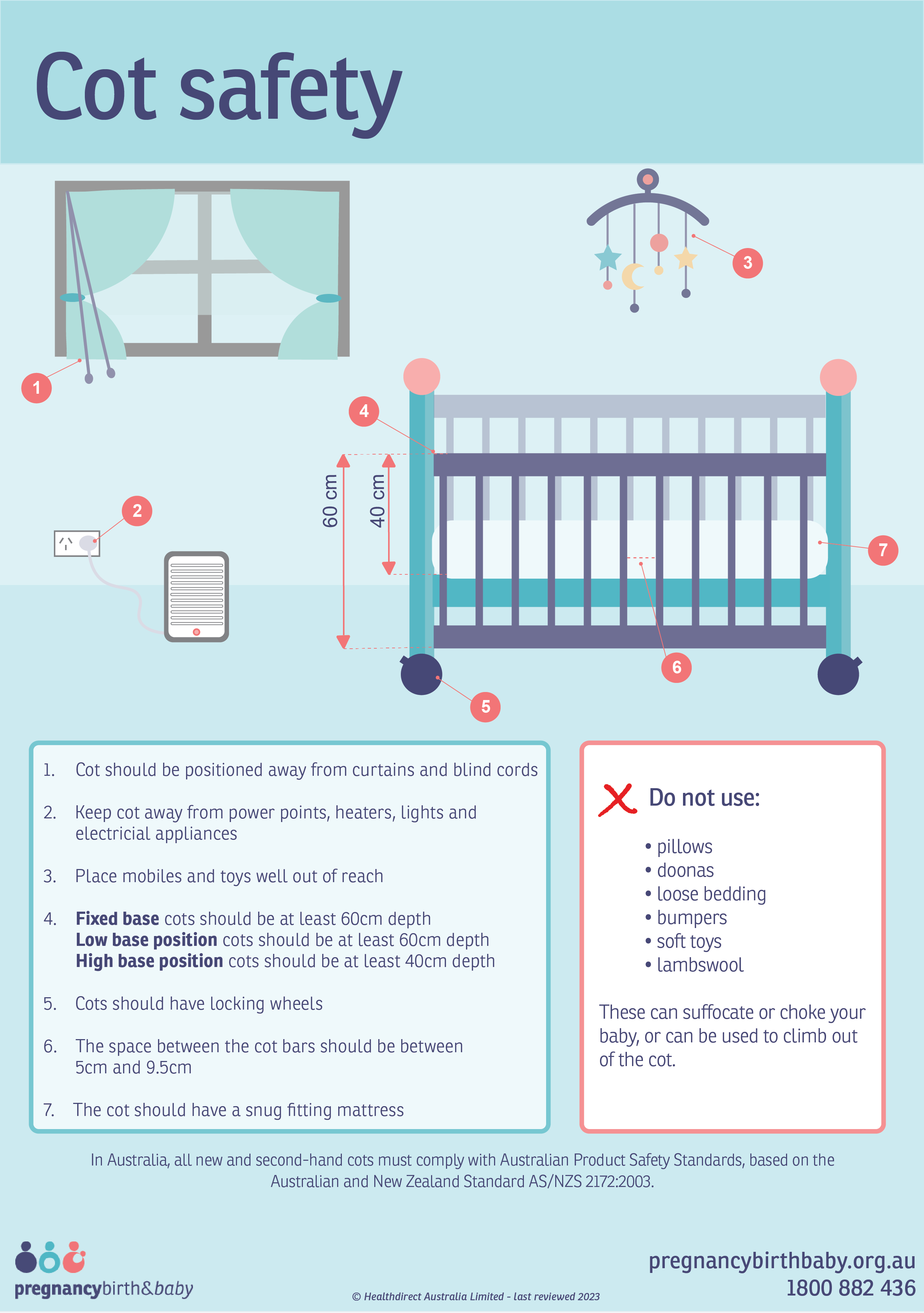Cots
7-minute read
Key facts
- Cots are a contained space for your child to rest.
- Cots should meet Australian Product Safety Standards to keep your child safe while sleeping.
- There are ways you can check that your cot meets safety requirements.
What is a cot?
Cots are a contained sleeping environment where children can be left to rest. It is important that cots are safe and secure.
What cot should I buy?
In Australia, all new and second-hand cots must comply with Australian Product Safety Standards. These are based on the Australian and New Zealand Standard AS/NZS 2172:2003.
You do not have to buy the latest or most expensive model of cot. Whatever cot you choose, it’s very important to make sure it meets the specific safety requirements. That is because babies and young children can become injured or even die in unsafe cots.
These requirements ensure your child sleeps safely, and reduces their risk of:
- climbing or falling out of the cot
- getting their fingers, limbs, head or clothes stuck
- suffocation or strangulation
Cot safety checklist
When you buy a cot, there are things you can do to check it meets the current safety requirements.
Using a tape measure, you can check the dimensions of the cot.
Make sure that:
- spaces between the bars of the cot are between 5cm and 9.5cm
- there are no protrusions over 5cm long
You should also make sure that there are no gaps in the cot:
- between 3cm and 5cm
- between 5cm and 12cm
- over 9.5cm
Cots can have a fixed height. They can also have an adjustable base, giving an upper and a lower height.
For young babies, the cot should be set at the upper height. For older babies, it should be set at the lower height so that they can’t fall out.
Depending on the height, the cot should be at a certain depth – the distance from the base of the mattress to the top of the lowest side.
- Cots with a fixed height should have a depth of at least 60cm.
- Cots set to the lower height should have a depth of at least 60cm.
- Cots set to the upper height should have a depth of at least 40cm.
Also check that there are no bars, ledges or other footholds that a toddler can use to climb out of the cot.
Should I buy a second-hand cot?
Before you buy or use a second-hand cot, go through the safety checklist.
There are some exceptions for used or second-hand cots.
- Protrusions must not be over 8cm long.
- There is no requirement preventing gaps between 3cm and 5cm.
- They do not require safety labels
You should only use a second-hand cot:
- with all parts in working order
- that comes with full instructions to set it up safely
If there are any broken or wobbly bars, repair them before your baby sleeps in the cot.
It is also important to check old cots for poisonous lead-based paint.
What mattress should I buy for my baby’s cot?
Softer mattresses can be dangerous, as they
- make it easier for your baby to roll over
- become more uneven as your baby gets heavier
It’s important to choose a mattress that is firm and well-fitting.
The space between the mattress and the sides of the cot should be:
- no more than 2.5cm when the mattress is in the centre of the cot
- no more than 4cm when the mattress is pushed to the side of the cot
Plastic wrapping can suffocate a baby or young child. Make sure you remove all plastic wrapping from a new mattress.
What are portable cots?
Portable cots are designed to be used temporarily. Because they can fold, this makes it easier for children to climb out of them or become trapped. This can dangerous.
Only buy a portable cot if it meets the Australian Safety Standard. Make sure:
- it is in good working order
- you set it up by following the instructions exactly, so it does not collapse
Do not use a thick mattress or an extra layer in a portable cot. This is because your baby can get caught between the mattress and the stretchable cot side. Make sure you buy a mattress that meets your specified cot dimensions.
Where should I put my baby’s cot?
When you bring the cot home, place it:
- away from the curtains, blind cords and other cords or ropes in which your baby could get tangled
- where mobiles and toys are well out of reach
- against walls that do not have pictures or mirrors that could fall and injure your baby
The cot should be away from:
- power points
- heaters
- electrical appliances
- lights
What bedding should I use in my baby’s cot?
Bedding can pose a risk to babies. You should be very careful that the bedding:
- cannot cover your baby's face
- cannot obstruct their breathing
A good choice of bedding is an infant sleeping bag, with:
- a fitted neck
- armholes
- no hood
If you are using blankets, make sure they:
- are tucked firmly into the mattress at the base
- do not come up further than your baby's chest
Place your baby with their feet at the base of the cot.
It’s recommended that you do not use things in the cot such as:
- pillows
- doonas
- loose bedding
- lambswool
- bumpers
- soft toys
These may:
- be used as climbing aids
- pose a choking risk
- suffocate the baby
Resources and support
For more information on cots and sleep safety, you can visit:
- the Australian Competition and Consumer Commission
- Red Nose
- Australian Children’s Education & Care Quality Authority
Speak to a maternal child health nurse

Speak to a maternal child health nurse
Call Pregnancy, Birth and Baby to speak to a maternal child health nurse on 1800 882 436 or video call. Available 7am to midnight (AET), 7 days a week.
